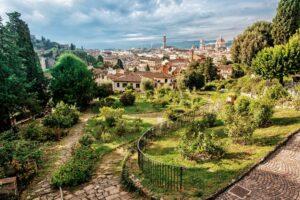Fodor's Expert Review Santa Maria Novella
The facade of this church looks distinctly clumsy by later Renaissance standards, and with good reason: it is an architectural hybrid. The lower half was completed mostly in the 14th century, and its pointed-arch niches and decorative marble patterns reflect the Gothic style of the day. About 100 years later (around 1456), architect Leon Battista Alberti was called in to complete the job. The marble decoration of his upper story clearly defers to the already existing work below, but the architectural motifs he added evince an entirely different style. The central doorway, the four ground-floor half-columns with Corinthian capitals, the triangular pediment atop the second story, the inscribed frieze immediately below the pediment—these are borrowings from antiquity, and they reflect the new Renaissance style in architecture, born some 35 years earlier at the Spedale degli Innocenti.
Alberti's most important addition—the S-curve scrolls (called volutes) surmounting the decorative... READ MORE
The facade of this church looks distinctly clumsy by later Renaissance standards, and with good reason: it is an architectural hybrid. The lower half was completed mostly in the 14th century, and its pointed-arch niches and decorative marble patterns reflect the Gothic style of the day. About 100 years later (around 1456), architect Leon Battista Alberti was called in to complete the job. The marble decoration of his upper story clearly defers to the already existing work below, but the architectural motifs he added evince an entirely different style. The central doorway, the four ground-floor half-columns with Corinthian capitals, the triangular pediment atop the second story, the inscribed frieze immediately below the pediment—these are borrowings from antiquity, and they reflect the new Renaissance style in architecture, born some 35 years earlier at the Spedale degli Innocenti.
Alberti's most important addition—the S-curve scrolls (called volutes) surmounting the decorative circles on either side of the upper story—had no precedent whatsoever in antiquity. The problem was to soften the abrupt transition between wide ground floor and narrow upper story. Alberti's solution turned out to be definitive. Once you start to look for them, you will find scrolls such as these (or sculptural variations of them) on churches all over Italy, and every one of them derives from Alberti's example here.
The architecture of the interior is, like that of the Duomo, a dignified but somber example of Florentine Gothic. Exploration is essential, however, because the church's store of art treasures is remarkable. Highlights include the 14th-century, stained-glass-rose window depicting the Coronation of the Virgin (above the central entrance); the Cappella Filippo Strozzi (to the right of the altar), containing late-15th-century frescoes and stained glass by Filippino Lippi; the cappella maggiore (the area around the high altar), displaying frescoes by Ghirlandaio; and the Cappella Gondi (to the left of the altar), containing Filippo Brunelleschi's famous wood crucifix, carved around 1410 and said to have so stunned the great Donatello when he first saw it that he dropped a basket of eggs.
Of special interest for its great historical importance and beauty is Masaccio's Trinity, on the left-hand wall, almost halfway down the nave. Painted around 1426–27 (at the same time he was working on his frescoes in Santa Maria del Carmine), it unequivocally announced the arrival of the Renaissance. The realism of the figure of Christ was revolutionary in itself, but what was probably even more startling to contemporary Florentines was the barrel vault in the background. The mathematical rules for employing single-point perspective in painting had just been discovered (probably by Brunelleschi), and this was one of the first works of art to employ them with utterly convincing success.
In the first cloister is a faded and damaged fresco cycle by Paolo Uccello depicting tales from Genesis, with a dramatic vision of the Deluge (at this writing, in restoration). Earlier and better-preserved frescoes painted in 1348–55 by Andrea da Firenze are in the chapter house, or the Cappellone degli Spagnoli (Spanish Chapel), off the cloister.
READ LESS







